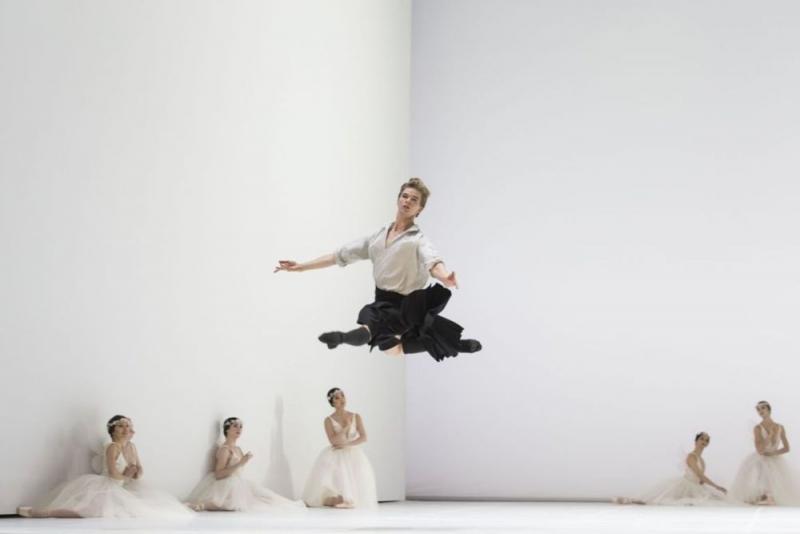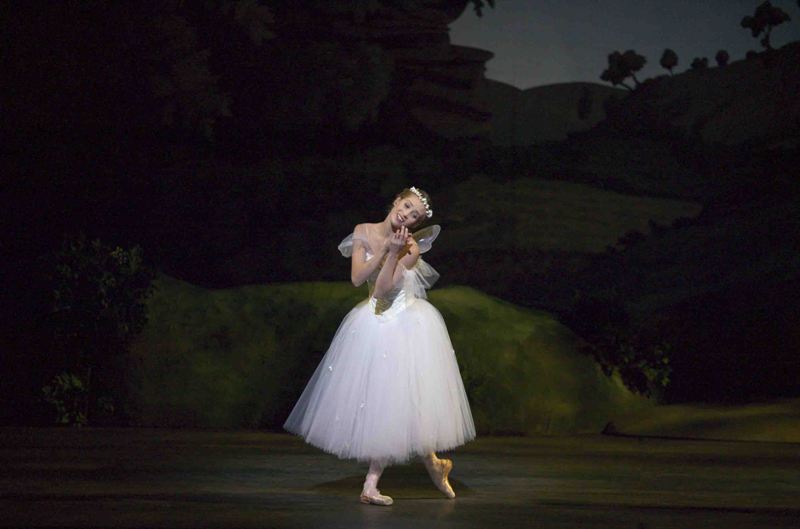Royal Danish Ballet Soloists and Principals, Peacock Theatre, London | reviews, news & interviews
Royal Danish Ballet Soloists and Principals, Peacock Theatre, London
Royal Danish Ballet Soloists and Principals, Peacock Theatre, London
The Scandinavian stylists give a tantalising glimpse of their Royal jewels

“A link in the chain of beauty” – that’s how the choreographer August Bournonville, in the 1840s, wanted every dancer in the Royal Danish Ballet to regard their art. And, remarkably, the chain of beauty we now call the Bournonville style has remained unbroken ever since.
Happily for us, today’s company has made it its business to pack this precious inheritance into a cabin-size flight bag for foreign visits. Less happily, as on its last outing to London 10 years ago, it sent only a dozen dancers, a gala-style programme of bits and bobs, no scenery and no orchestra – just a blue backdrop and taped music. And it scheduled only three performances. You want complete works? Then go to Copenhagen, or New York, or Jacob’s Pillow in Massachusetts, which manages to fund more substantial visits from the full company, and more frequent. This might have something to do with the fact that the Danish school has produced some of American ballet’s biggest male stars, such as Erik Bruhn and Nikolaj Hubbe.
The programme at the Peacock was more finger buffet than three-course meal. The longest excerpts were from La Sylphide (1836) and Napoli (1842), both highly accessible narrative ballets when presented intact, but here so severely shorn of dramatic context that a newcomer to the work might have gone home believing there was no story to tell. The wedding dances from Napoli which closed the programme survived this treatment best, summoning the spirit of an ebullient Neapolitan party with subtle flirting and spectacular showing off breaking through the elegent sheen of gracious manners. Within a milling stage picture, even while the overall mood became giddier, each individual became steadily more distinct as a character. It was well done.
Act II of La Sylphide, by contrast, suffered more from the empty stage. Granted, the budget may not stretch to a Highland glade, but a simple projection of fir trees would have helped. As it was, there was little indication that Ulrik Birkkjaer’s bekilted James was pursuing the Sylph out of doors until she presented him with a handful of foraged berries. And for further help, why not include a snatch of the cauldron scene from earlier in the ballet, to explain how the wedding veil offered to James by the witch Madge (a wonderfully crabby Sorella Englund) comes to be laced with poison? Perhaps the Danes have lived with this story so long that they think everyone else knows it too. A pity, since Gudrun Bojesen captured beautifully the Sylph’s minxy combination of blank amorality and childish playfulness. Birkkjaer’s James can’t suppress his delight at being allowed to dance with her and her ethereal sisters, among whom Susanne Grinder was exceptional for her gauzy weightlessness.
What distinguishes the Romantic style, beyond the courtly manners and demure, below-the-knee tutus, is what dancers call, using the French term, placement – the positioning of the arms, head and shoulders – and also its extreme buoyancy (particularly for the men) and fast-beaten footwork. The remainder of the programme, for all its bittiness, proved a fine showcase for this. The pas de deux that is now all that remains of the 1858 ballet Flower Festival in Genzano would be horribly coy in the wrong hands, as well as a technical tripwire, but Diana Cuni and Andreas Kass are so convincing in their bashful and fleet-footed courtship that you feel you ought to buy them a shandy. Kass's cork-popping vertical jumps are astonishing.
The printed programme, more helpful than many, lets drop intriguing information about the original productions we don't get to see. A Folk Tale (1854), reduced to an abstract pas de sept, was “about a girl called Hilda who lives in the hill with a witch and her trolls”, which sounds a whole lot of fun, not even hinted at on stage at the Peacock. The amusing Jockey Dance, a segment of From Siberia to Moscow (1876), was originally the British segment of a set of character dances each symbolising a European river – the Thames represented (why, you wonder) by horse-racing and betting. The two Frankie Dettori-style rivals are boundingly embodied by Marcin Kupinski and Sebastian Haynes. With a leggy gallop like theirs, who needs a horse?
There is, in short, a world of interest lying in wait for British audiences, should they one day get a proper chance to see some of the complete extant ballets of August Bournonville. How about it, Sadler's Wells?
rating
Explore topics
Share this article
Add comment
The future of Arts Journalism
You can stop theartsdesk.com closing!
We urgently need financing to survive. Our fundraising drive has thus far raised £49,000 but we need to reach £100,000 or we will be forced to close. Please contribute here: https://gofund.me/c3f6033d
And if you can forward this information to anyone who might assist, we’d be grateful.

Subscribe to theartsdesk.com
Thank you for continuing to read our work on theartsdesk.com. For unlimited access to every article in its entirety, including our archive of more than 15,000 pieces, we're asking for £5 per month or £40 per year. We feel it's a very good deal, and hope you do too.
To take a subscription now simply click here.
And if you're looking for that extra gift for a friend or family member, why not treat them to a theartsdesk.com gift subscription?
more Dance
 'We are bowled over!' Thank you for your messages of love and support
Much-appreciated words of commendation from readers and the cultural community
'We are bowled over!' Thank you for your messages of love and support
Much-appreciated words of commendation from readers and the cultural community
 R:Evolution, English National Ballet, Sadler's Wells review - a vibrant survey of ballet in four acts
ENB set the bar high with this mixed bill, but they meet its challenges thrillingly
R:Evolution, English National Ballet, Sadler's Wells review - a vibrant survey of ballet in four acts
ENB set the bar high with this mixed bill, but they meet its challenges thrillingly
 Like Water for Chocolate, Royal Ballet review - splendid dancing and sets, but there's too much plot
Christopher Wheeldon's version looks great but is too muddling to connect with fully
Like Water for Chocolate, Royal Ballet review - splendid dancing and sets, but there's too much plot
Christopher Wheeldon's version looks great but is too muddling to connect with fully
 iD-Reloaded, Cirque Éloize, Marlowe Theatre, Canterbury review - attitude, energy and invention
A riotous blend of urban dance music, hip hop and contemporary circus
iD-Reloaded, Cirque Éloize, Marlowe Theatre, Canterbury review - attitude, energy and invention
A riotous blend of urban dance music, hip hop and contemporary circus
 How to be a Dancer in 72,000 Easy Lessons, Teaċ Daṁsa review - a riveting account of a life in dance
Michael Keegan-Dolan's unique hybrid of physical theatre and comic monologue
How to be a Dancer in 72,000 Easy Lessons, Teaċ Daṁsa review - a riveting account of a life in dance
Michael Keegan-Dolan's unique hybrid of physical theatre and comic monologue
 A Single Man, Linbury Theatre review - an anatomy of melancholy, with breaks in the clouds
Ed Watson and Jonathan Goddard are extraordinary in Jonathan Watkins' dance theatre adaptation of Isherwood's novel
A Single Man, Linbury Theatre review - an anatomy of melancholy, with breaks in the clouds
Ed Watson and Jonathan Goddard are extraordinary in Jonathan Watkins' dance theatre adaptation of Isherwood's novel
 Peaky Blinders: The Redemption of Thomas Shelby, Rambert, Sadler's Wells review - exciting dancing, if you can see it
Six TV series reduced to 100 minutes' dance time doesn't quite compute
Peaky Blinders: The Redemption of Thomas Shelby, Rambert, Sadler's Wells review - exciting dancing, if you can see it
Six TV series reduced to 100 minutes' dance time doesn't quite compute
 Giselle, National Ballet of Japan review - return of a classic, refreshed and impeccably danced
First visit by Miyako Yoshida's company leaves you wanting more
Giselle, National Ballet of Japan review - return of a classic, refreshed and impeccably danced
First visit by Miyako Yoshida's company leaves you wanting more
 Quadrophenia, Sadler's Wells review - missed opportunity to give new stage life to a Who classic
The brilliant cast need a tighter score and a stronger narrative
Quadrophenia, Sadler's Wells review - missed opportunity to give new stage life to a Who classic
The brilliant cast need a tighter score and a stronger narrative
 The Midnight Bell, Sadler's Wells review - a first reprise for one of Matthew Bourne's most compelling shows to date
The after-hours lives of the sad and lonely are drawn with compassion, originality and skill
The Midnight Bell, Sadler's Wells review - a first reprise for one of Matthew Bourne's most compelling shows to date
The after-hours lives of the sad and lonely are drawn with compassion, originality and skill
 Ballet to Broadway: Wheeldon Works, Royal Ballet review - the impressive range and reach of Christopher Wheeldon's craft
The title says it: as dancemaker, as creative magnet, the man clearly works his socks off
Ballet to Broadway: Wheeldon Works, Royal Ballet review - the impressive range and reach of Christopher Wheeldon's craft
The title says it: as dancemaker, as creative magnet, the man clearly works his socks off
 The Forsythe Programme, English National Ballet review - brains, beauty and bravura
Once again the veteran choreographer and maverick William Forsythe raises ENB's game
The Forsythe Programme, English National Ballet review - brains, beauty and bravura
Once again the veteran choreographer and maverick William Forsythe raises ENB's game

Comments
The picture caption